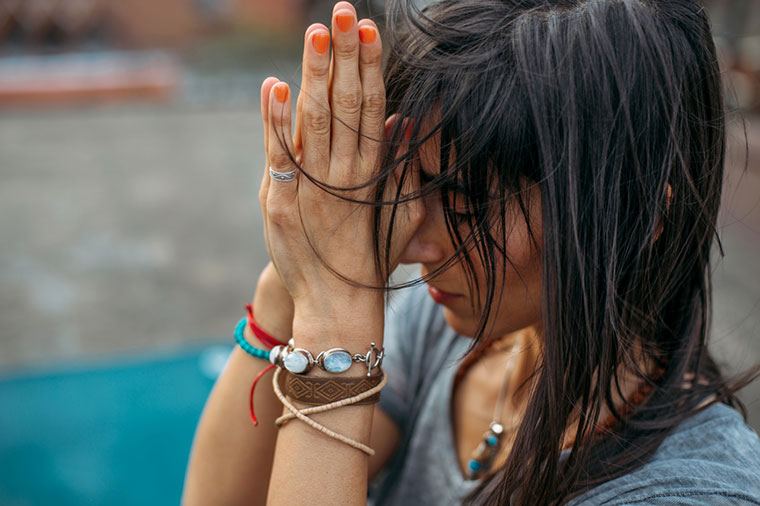The Increasing Problem of Shamans Taking Advantage of Women—and How to Make Sure You Don’t Fall Victim
Sarah Eve Cardell was 28 when she embarked on a soul-searching trip through Southeast Asia. A certified Dharma yoga teacher and raw food chef, she wanted to meet as many shamans and healers as she could, soaking up their knowledge. "I was just so open and eager to learn anything and everything," she says.
While in Amed (a remote part of Bali), she met a man outside of her hotel who claimed to be a shaman. "He was telling me about his spirituality, practice, and his ability to be a healer," remembers Cardell. "He even said he could make the sky rain whenever he wanted." The man invited her to his house to experience his healing firsthand. Cardell, excited for the experience, quickly accepted.
But before long, the wellness-seeker wished that she hadn't—and was starting to wonder what she had gotten herself into."We climbed on his motorcycle and he drove really fast, like he wanted to show me he was in control," Cardell says. Ultimately, they arrived at his "spiritual house and sacred space"—but when Cardell looked around and saw various skulls and bones, she began to feel uncomfortable.
"I didn't know what it was and I was afraid he was leaving me in there to pass out."
Then, the man started burning something, and he closed the door and left. "I didn't know what it was and I was afraid he was leaving me in there to pass out," she says. "I just felt so high." She convinced the shaman to take her back to her hotel—which he did, reluctantly.

{{post.sponsorText}}
Cardell is an experienced traveler and had been studying with many shamans—AKA healers who help you work on your physical, emotional, and spiritual health—before that harrowing experience in Bali. In fact, she had even started offering her own shamanic healing workshops. Yet even she unknowingly put herself in a dangerous situation. And she's certainly not alone.
As spiritual travel booms (thanks, Eat Pray Love), so too do the opportunities for uncomfortable, frightening, or even traumatic experience. It's hard to determine just how widespread the problem is (shame is a powerful silencer, after all), but at a time when shamans are more common than ever—your friend who got certified in yoga five years ago is probably studying it right now—the whispers in the wellness community about shady faux-healers are starting to get louder.
Here's what you need to know about finding an authentic shaman.

Money isn't the main motivator
Shamans aren't exactly flooding your Facebook feed with invitations or putting up billboards. (It would be pretty weird if they were, right?) "Word of mouth is the best way to find a trustworthy shaman," says Jill Blakeway, a Traditional Chinese Medicine doctor, acupuncturist, energy healer, and co-founder of New York City's YinOva Center, who is currently writing a book about shamans. Listening to someone's firsthand experience is a much safer bet than blindly choosing a shaman you don't know much about, she says.
What about shamans and money? Does a "good" one charge you? "There has to be some sort of energy exchange," Cardell says. Blakeway agrees, adding that there's nothing wrong with a shaman charging for his or her work, but dollar bills should not be their driving factor. "People need to live and be paid for what they do, but an authentic shaman feels led to the practice," she says. So if a shaman keeps bringing up payment or there are many hidden fees, consider it a red flag.

It took them way more than a weekend to "become" a shaman
Blakeway explains that many people take a short course in healing work and go on to call themselves a shaman. "They might genuinely be helping people, but traditionally that isn't exactly how shamanism works," she says. "Most initially became shamans through initiation or through their ancestors, and the process is very long, often a lifetime or, in some ways, many lifetimes," she says.
Many of the people Blakeway interviewed for her book are 10th-generation shamans, but even so, they're hesitant to use the term, often preferring the more humble term "healer" instead.
"Most genuine shamans have a story about how they were called into the practice through a dream or sign," she says. "And many have experienced some sort of crisis, whether physical, emotional, or physical. It's this idea that you can't take someone to a place you haven't been yourself."

They make you feel free, not fearful
Blakeway says there are a few key things that are sacred to every shaman—regardless of where in the world you encounter one: They all use nature as part of healing, communicating with Mother Earth by talking to plants and animals; they all have a ceremony that leads to visions and altered states; and they all believe in sacred places in nature that have a special spiritual energy.
"As much buzz as ayahuasca ceremonies get, the vast majority of shamans don't use hallucinogenic plants," Blakeway says. "Often, they use sound, like monotonous percussion, drums, or rattles to bring people to altered states."
Blakeway and Cardell both agree that a genuine healer will never push you to do anything you feel uncomfortable with. "A good shaman isn’t trying to control you. They’re not judging you or being tied up in your dramas; they’re honoring your choices and giving you space to honor your experiences," Blakeway notes.
"You should feel more free in all areas: physically, mentally, spiritually," Cardell adds. "It should be a liberating experience and not something where you're questioning where the boundaries are. That question shouldn’t even come up in your mind."
The popularity of shamanic practices is part of the rise of woo-woo wellness. Even more popular? Crystals. Here's how to heal your home, room-by-room.
Loading More Posts...